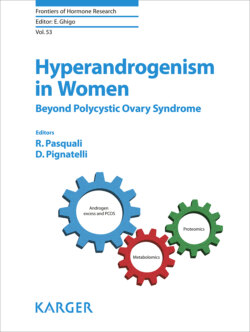Читать книгу Hyperandrogenism in Women - Группа авторов - Страница 29
The Effects of Androgens on Fat Mass
ОглавлениеThe clinical feature that men and women differ both for FM and for fat distribution has drawn the attention on the possible effects of sex hormones, especially of the androgens, on adipose tissue. Indeed, given the same BMI, women are characterized by higher percentage of FM, with adipose tissue accumulating in gluteal and femoral regions, whereas men have higher FFM, showing adipose tissue predominantly at the abdominal region. This difference is commonly regarded as gynoid and android fat pattern, or peripheral and central, or “pear” and “apple.” Besides topography, sexes differ for the characteristic of FM, with VAT carrying an increased metabolic, cardiovascular, and cancer risk [14–16] (Fig. 1, 2).
Androgens exert an opposite effect depending on sex, highlighting the key role of genetic background, metabolism and distribution of AR. In women, higher levels of total and free T and A have been associated with increased VAT and waist circumference [14]. These data largely rely on a large number of observational studies conducted in women affected by polycystic ovary syndrome (PCOS) and, moreover, have been confirmed in a randomized clinical trial on healthy obese postmenopausal women under weight loss through diet: the administration of nandrolone decanoate (a weak androgen) was associated with gain in VAT and reduced FM loss when compared to spironolactone (an antiandrogen) and placebo therapy [17, 18].
Fig. 2. Body fat mass percentage across life in healthy women and levels of sexual hormones. Sexual hormones were indirectly evaluated either by RIA involving chromatography steps (before the 2000s) or by mass spectrometry [51, 93, 94, 99, 100].
Conversely, in men, lower total T, free T, and weak androgen levels have been associated with increased FM and especially VAT [14, 15]. This has consistently been described in population studies: obese men when compared to non-obese subjects of similar age show lower androgen levels; among overweight and obese with similar BMI (mean 30 kg/m2), men with higher percentage of FM have lower androgen levels [19, 20]. Moreover, healthy eugonadal men undergoing T suppression through GnRH analogues showed an increase in FM and a decrease in FFM, which were partially reversed when T was administered [16, 21–25]; similar results were found among overweight adults undergoing pharmacological castration with GnRH antagonist (acycline) [26].
It is interesting to note that the effects of T on adipose tissue and muscle mass depend on its absolute serum levels in both sexes, rather than the relative levels compared to healthy people. In adults, total T levels between 100 and 300 ng/dL facilitates hypertrophy and hyperplasia of VAT, leading to inflammation and insulin resistance: in females this is associated with PCOS, in males with hypogonadism [11]. Similarly, in male adolescents, the absolute serum levels of T play a crucial role in modulating the body composition. As a matter of fact, the progressive rise in T serum levels (from 100 to >300 ng/dL) drives the bone maturation and raise both the mineral density and the FFM. In obese adolescent, however, serum T is lower (between 50 and 300 ng/dL), while oestrogens are up to twice when compared to non-obese subjects [27, 28].
